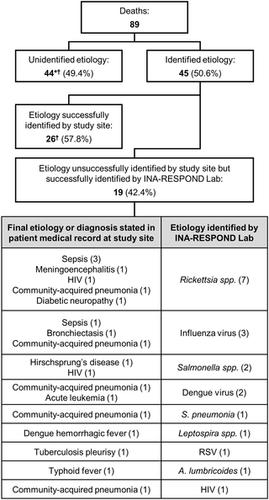当前位置:
X-MOL 学术
›
PLOS Negl. Trop. Dis.
›
论文详情
Our official English website, www.x-mol.net, welcomes your
feedback! (Note: you will need to create a separate account there.)
An observational prospective cohort study of the epidemiology of hospitalized patients with acute febrile illness in Indonesia.
PLOS Neglected Tropical Diseases ( IF 3.4 ) Pub Date : 2020-01-10 , DOI: 10.1371/journal.pntd.0007927 Muhammad Hussein Gasem 1 , Herman Kosasih 2 , Emiliana Tjitra 3 , Bachti Alisjahbana 4 , Muhammad Karyana 3 , Dewi Lokida 5 , Aaron Neal 6 , C Jason Liang 6 , Abu Tholib Aman 7 , Mansyur Arif 8 , Pratiwi Sudarmono 9 , Suharto 10 , Tuti Parwati Merati 11 , Vivi Lisdawati 12 , Siswanto 3 , Sophia Siddiqui 6 , H Clifford Lane 6 ,
PLOS Neglected Tropical Diseases ( IF 3.4 ) Pub Date : 2020-01-10 , DOI: 10.1371/journal.pntd.0007927 Muhammad Hussein Gasem 1 , Herman Kosasih 2 , Emiliana Tjitra 3 , Bachti Alisjahbana 4 , Muhammad Karyana 3 , Dewi Lokida 5 , Aaron Neal 6 , C Jason Liang 6 , Abu Tholib Aman 7 , Mansyur Arif 8 , Pratiwi Sudarmono 9 , Suharto 10 , Tuti Parwati Merati 11 , Vivi Lisdawati 12 , Siswanto 3 , Sophia Siddiqui 6 , H Clifford Lane 6 ,
Affiliation

|
BACKGROUND
The epidemiology of acute febrile illness, a common cause of hospitalization in Indonesia, has not been systematically studied.
METHODOLOGY/PRINCIPAL FINDINGS
This prospective observational study enrolled febrile patients (temperature ≥38°C) aged ≥1 year from July 2013 until June 2016 at eight government referral teaching hospitals in seven provincial capitals in Indonesia. Patients were managed according to the hospital standard-of-care (SOC), and blood samples were drawn for molecular and serological assays. Clinical data, laboratory results, and specimens for additional tests were collected at enrollment, days 14-28, and at three months. Regular follow-up visits were then scheduled for every three months either until symptoms resolved or until one year. In total, this study included 1,486 adult and pediatric patients presenting with multi-organ (768, 51.7%), gastrointestinal (497, 33.0%), respiratory (114, 7.7%), constitutional (62, 4.2%), skin and soft-tissue (24, 1.6%), central nervous system (17, 1.1%), or genitourinary (4, 0.3%) manifestations. Microbiological diagnoses were found in 1,003/1,486 (67.5%) participants, of which 351/1,003 (35.0%) were not diagnosed during hospitalization using SOC diagnostic tests. Missed diagnoses included all cases caused by Rickettsia spp., chikungunya, influenza, and Seoul virus. The most common etiologic agents identified were dengue virus (467, 46.6%), Salmonella spp. (103, 10.3%), and Rickettsia spp. (103, 10.3%). The overall mortality was 89 (5.9%).
CONCLUSIONS/SIGNIFICANCE
Febrile illness in Indonesia has various microbiologic etiologies and substantial overall mortality. Diagnostic limitations and lack of epidemiologic data resulted in potentially treatable, and at times fatal, diseases being missed.
中文翻译:

一项针对印度尼西亚急性发热性疾病住院患者流行病学的观察性前瞻性队列研究。
背景 急性发热性疾病是印度尼西亚住院的常见原因,其流行病学尚未得到系统研究。方法/主要发现 这项前瞻性观察性研究纳入了 2013 年 7 月至 2016 年 6 月期间在印度尼西亚七个省会城市的八家政府转诊教学医院年龄≥1 岁的发热患者(体温≥38°C)。根据医院护理标准(SOC)对患者进行管理,并抽取血样进行分子和血清学检测。在入组时、第 14-28 天以及三个月时收集临床数据、实验室结果和用于额外测试的样本。然后每三个月安排一次定期随访,直到症状消失或直到一年。这项研究总共包括 1,486 名成人和儿童患者,其症状包括多器官(768 例,51.7%)、胃肠道(497 例,33.0%)、呼吸系统(114 例,7.7%)、体质(62 例,4.2%)、皮肤和软组织疾病。 -组织(24,1.6%)、中枢神经系统(17,1.1%)或泌尿生殖(4,0.3%)表现。 1,003/1,486 (67.5%) 名参与者中发现了微生物学诊断,其中 351/1,003 (35.0%) 名参与者在住院期间使用 SOC 诊断测试未得到诊断。漏诊包括由立克次体、基孔肯雅热、流感和首尔病毒引起的所有病例。最常见的病原体是登革热病毒(467 例,46.6%)、沙门氏菌属。 (103, 10.3%) 和立克次体属。 (103,10.3%)。总死亡率为 89 人(5.9%)。结论/意义 印度尼西亚的发热性疾病具有多种微生物学病因和较高的总体死亡率。诊断的局限性和流行病学数据的缺乏导致了可能可治疗的、有时甚至是致命的疾病被遗漏。
更新日期:2020-01-10
中文翻译:

一项针对印度尼西亚急性发热性疾病住院患者流行病学的观察性前瞻性队列研究。
背景 急性发热性疾病是印度尼西亚住院的常见原因,其流行病学尚未得到系统研究。方法/主要发现 这项前瞻性观察性研究纳入了 2013 年 7 月至 2016 年 6 月期间在印度尼西亚七个省会城市的八家政府转诊教学医院年龄≥1 岁的发热患者(体温≥38°C)。根据医院护理标准(SOC)对患者进行管理,并抽取血样进行分子和血清学检测。在入组时、第 14-28 天以及三个月时收集临床数据、实验室结果和用于额外测试的样本。然后每三个月安排一次定期随访,直到症状消失或直到一年。这项研究总共包括 1,486 名成人和儿童患者,其症状包括多器官(768 例,51.7%)、胃肠道(497 例,33.0%)、呼吸系统(114 例,7.7%)、体质(62 例,4.2%)、皮肤和软组织疾病。 -组织(24,1.6%)、中枢神经系统(17,1.1%)或泌尿生殖(4,0.3%)表现。 1,003/1,486 (67.5%) 名参与者中发现了微生物学诊断,其中 351/1,003 (35.0%) 名参与者在住院期间使用 SOC 诊断测试未得到诊断。漏诊包括由立克次体、基孔肯雅热、流感和首尔病毒引起的所有病例。最常见的病原体是登革热病毒(467 例,46.6%)、沙门氏菌属。 (103, 10.3%) 和立克次体属。 (103,10.3%)。总死亡率为 89 人(5.9%)。结论/意义 印度尼西亚的发热性疾病具有多种微生物学病因和较高的总体死亡率。诊断的局限性和流行病学数据的缺乏导致了可能可治疗的、有时甚至是致命的疾病被遗漏。











































 京公网安备 11010802027423号
京公网安备 11010802027423号